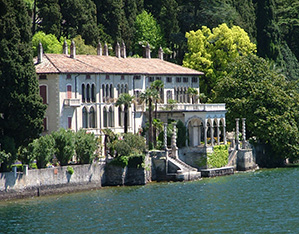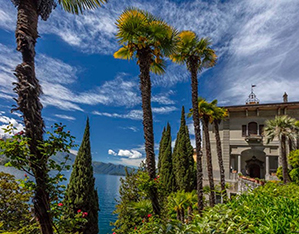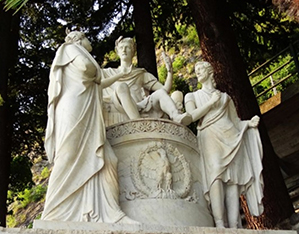The ultimate lakeside garden, with gravel parterres overlooking the lake, flowered balustrades, lush exotic vegetation and Baroque ornamentations, Villa Monastero is the location that inspired the romantic and decadent settings of “Nadejde” by novelist Antonio Fogazzaro
The presence of an aromatic and medicinal herb garden is documented since the times of the Cistercian monastery pre-existent to the villa. Abandoned in 1567, the monastery was bought and transformed into a residence by Paolo Mornico. Further alterations were introduced by his son Lelio between 1609 and 1645. The villa, which includes the old monastery chapel, remained property of the Mornico family until 1862. It then changed hands several times until 1897 when it was bought by the German industrialist Walter Kees. The current extension of the garden is a result of the interventions carried out between 1897 and 1909: the different sections of the outdoor space are laid out on terraces overlooking the lake, along an about two-kilometres stretch in a highly panoramic position. The main terrace, which extends beyond the Guesthouse, features a formal garden design. Balustrades with sculptural groups and a four-basin Baroque fountain complete the space with a touch of refinement. A monumental staircase, opening with twisted columns and surmounted by a belvedere, leads to the lake. Among the terraces, a small temple crowns the slope. Beyond the villa, past the monumental palms and the old lemon tree house, the garden presents a landscaped layout with winding paths, clearings, and wooded areas with statues, furnishings and several exotic and rare species. At the southern margin of this section there is the Kaffeehaus. Requisitioned during World War I, the villa was then sold to the naturalist Marco De Marchi who incremented Villa Monastero’s botanical collections. In 1940, in keeping with De Marchi’s wish, the complex become accessible to the public. Former seat of the De Marchi Institute for Hydrobiology, today the villa belongs to Italy’s CNR National Research Council, which has entrusted its management to the Province of Lecco, through the institution named “Villa Monastero”.
Highlights

The villa and its interiors
Although drawing inspiration by Villa Melzi and Villa Balbianello, Kees adopted the 19th-century historicist style with references to the Bavarian castles of Linderhof and Herrenchiemsee. The 17th-century building became a comfortable residence, equipped with a central heating system and eclectic style furnishings.

Botanical Heritage
In line with the taste and botanical interests that underpinned Lake Como gardens in the late 19th century, Villa Monastero is home to over 900 botanical species from all over the world: African and American palms, exotic conifers, magnolias, agaves, yuccas, dracaenas and oleanders, plus a selection of botanical rarities such as the Erythea armata, a palm tree with large, silvery, fan-shaped leaves, theChamaerops excelsa and Chamaerops humilis, theJubaea spectabilis, the Pinus montezumae and a significant collection of citrus trees.

"La Clemenza di Tito" (The Clemency of Titus)
The park is home to the last work by neoclassical sculptor Giovanni Battista Comolli: La Clemenza di Tito (The Clemency of Titus). On its plinth, a 19th-century inscription reads: “Death took the chisel that sculpted this historic emblem from Gio Battista Comolli’s hand on 20 December 1830”.
 Villa Monastero
Contacts
Villa Monastero
Contacts
 Villa Monastero
Opening times and prices
Villa Monastero
Opening times and prices
Opening hours
Botanical Garden (Season 2021)
- January: 9, 10, 17, 24, 31 from 10 a.m. to 5 p.m.
- February: 19, 20, 21, 26, 27, 28 from 10 a.m. to 5 p.m. (days and times may vary due to health emergency)
- March: daily from 10 a.m. to 5 p.m. (days and times may vary due to health emergencies)
- April and May: every day from 9.30 a.m. to 7.30 p.m.
- June, July and August: daily from 9.30 a.m. to 8 p.m.
- September: every day from 9.30 a.m. to 7.30 p.m.
- from 1 October to 1 November: every day from 10 a.m. to 6 p.m.
- November: 7, 14, 21, 28 from 10 a.m. to 5 p.m.
- December: 5, 8, 12, 19, 26 to 31 from 10 a.m. to 5 p.m.
Casa Museo (Season 2021)
- January: Sundays 17, 24, 31 from 10 a.m. to 5 p.m.
- February: 19, 26 February from 10 a.m. to 5 p.m. (days and times may vary due to health emergency)
- March: Fridays, Saturdays and Sundays from 10 a.m. to 5 p.m. (days and times may vary due to health emergencies)
- April and May: Tuesday and Sunday and holidays from 9.30 a.m. to 7.30 p.m.
- June, July and August: daily from 9.30 a.m. to 8 p.m.
- September: Tuesday to Sunday from 9.30 a.m. to 7.30 p.m.
- from 1st October to 1st November: Tuesday to Sunday from 10 a.m. to 6 p.m.
- November: 7, 14, 21, 28 from 10 a.m. to 5 p.m.
- December: 5, 8, 12, 19, 26 to 31 from 10 a.m. to 5 p.m.
Pricing
Botanical Garden
- Full price € 8,00
- Reduced € 5,00 (over 65, groups of at least 10 people, members of Touring Club Italiano, members of the Associazione Gite in Lombardia, residents in the province of Lecco)
- Reduced € 3,50 (children 12-18 years and students 18-24 years)
- Free for children 0-11 years old, disabled people and their carers, ICOM members, Abbonamento Musei Lombardia holders, Varenna residents, journalists, participants in educational courses approved by the Province of Lecco.
Botanical Garden + Casa Museo
- Full price € 10,00
- Reduced € 7,00 (over 65, groups of at least 10 people, members of Touring Club Italiano, members of Associazione Gite in Lombardia, residents in the province of Lecco)
- Reduced € 5,00 (children from 12 to 18 years old and students from 18 to 24 years old)
- Free for children 0-11 years old, disabled people and their carers, ICOM members, Abbonamento Musei Lombardia holders, Varenna residents, journalists, participants in educational courses approved by the Province of Lecco.
Qualified tourist guides, tour leaders and environmental excursion guides are free of charge when accompanying a group. The ticket office closes 30 minutes before the closing time of the Villa. Access allowed to individuals and families without reservation. Access allowed to small groups, with reservation, but not to large groups.
 Villa Monastero
How to get there
Villa Monastero
How to get there
Address
Viale Giovanni Polvani, 2
23829 , Varenna (LC)
Latitude: 45.9889074
Longitude: 9.2031925
How to arrive by road
FROM SOUTH along the SS36 of Lake Como and Spluga, along the Lecco branch. Varenna is about 30 km away from Lecco, exit Bellano/Valsassina. To enjoy the pleasant view of the lake you can also take the Mandello exit and continue on the state road adjacent to the lake. FROM NORTH along the SS 36 of Lake Como and Spluga Pass, crossing Valchiavenna from Spluga, or coming down from Engadina (Sankt Moritz). After Colico you travel about 14 km before taking the exit for Bellano/Valsassina; after about 6 km you arrive in Varenna, following the road adjacent to the lake.
How to arrive by train
Using the Trenitalia railway line: coming from Milan the line runs along the SS 36, and the station of Varenna-Esino is about 30 minutes away from Lecco; coming from Tirano the line runs along the SS 38 until Colico, and then continues along the SS 36. After passing Colico station it continues for about 20 minutes more.
How to arrive by bus
Using the connections that Lecco Trasporti offers, thanks to the line D21 Bellano – Varenna – Esino – Ortanella.
For information consult the website.
Additional directions
By Boat:
- using the navigation network of Lake Como. Varenna faces Bellagio and is perfectly connected with the other resorts of the lake, thanks also to its central location. For information visit the website
 Villa Monastero
Services/Accessibility
Villa Monastero
Services/Accessibility
Services
Villa Monastero offers visitors a bar service inside the botanical garden. The opening hours for the next few months are as follows: May and June: every day from 10 am to 7.30 pm July and August: every day from 9.30 am to 8 pm September: every day from 9.30 am to 7.30 pm October and until 1st November: every day from 10.00 am to 6.00 pm
Dogs are allowed only in the garden and on a leash.
In the House Museum of Villa Monastero, educational tours and activities have been organized in order to allow schoolchildren a correct reading of the collections present and the deepening of some issues related to history, art and nature. The courses have been identified and developed by professionals and organized for different age groups, based on different learning needs. The itineraries are interactive and take place in the form of a continuous dialogue between the educational operator and the pupils, in order to best stimulate the interest and curiosity of even the youngest children. The workshops include different activities and are designed to bring the students closer to some aspects of technical and artistic production. The cost for a half-day course is €50 per class for schools in the province of Lecco and €70 per class for schools outside the province of Lecco.
 Villa Monastero
Private events
Villa Monastero
Private events
At Villa Monastero you can organize many private events such as weddings, civil unions and photo shoots.
 Villa Monastero
Itineraries
Villa Monastero
Itineraries
You could find the garden in these itineraries
 Favorite saving result
Favorite saving result
 Warning!
Warning!
You've have to sign up or sign in to add this element to your favorites.
